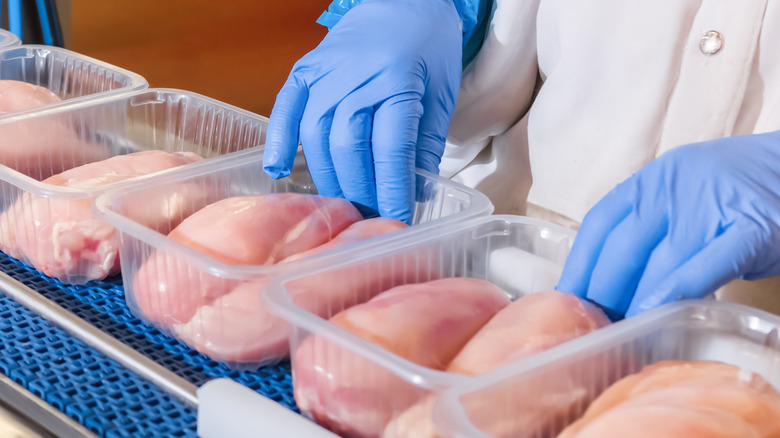The Visual Red Flags To Avoid When Buying Chicken
Chicken is wildly popular globally — more than 75 billion chickens were slaughtered for food in 2022, according to Our World in Data. But you have to treat it with respect because if it's not cooked properly chicken contains serious health risks. As the CDC makes clear, bacteria such as Salmonella, Clostridium Perfringens, and Campylobacter from undercooked chicken can cause all sorts of nasty food-borne illness symptoms, from diarrhea and nausea to fever and vomiting. Don't think you can look at the expiration date to tell whether a chicken is still good, either. Those numbers are usually manufacturer guesswork (and are just one of the myths about expiration dates you should stop believing). And since you're not supposed to wash raw chicken because it only spreads bacteria, you have to get it right at the time of purchase. So, how do you tell if the poultry you're buying from the grocery store is in good shape?
The good news is there are several ways to tell from looking at raw chicken whether it's still good. You want to make sure the meat isn't dull and gray, because that's definitely past its prime. You also want to look for any damage to the meat itself, such as rips or discoloration, and ensure there isn't too much liquid pooling in the container (although this last one is about quality rather than food safety).
There are several key ways to immediately spot bad chicken
The first question you should ask is: What does the color of the meat look like? You want a light-meat chicken to be a pale and rosy pink, while dark-meat varieties should be a darker pink — and both should have a noticeable shine. Chicken meat that's started to go bad will take on a gray color and a dull appearance. You also want to make sure your chicken is undamaged. This obviously goes for the package, but it also applies to the chicken itself. If the meat has external damage or seems deflated, or even just bruised, don't buy it.
Lastly, if there is liquid pooling in the container, that's a bad sign, too. Excess liquid in the package comes from the chicken absorbing water while it was chilled. This one is different from the other visual guidelines because the excess liquid in a (properly sealed) package isn't a health risk. Instead, the expulsion of this water will have a detrimental effect on both the flavor and texture of the meat, turning it bland and mushy.
Don't discount your other senses, either
There are other ways to tell a grocery store cut of chicken isn't quite fresh, too, and they're all about using your other senses. If that supermarket chicken smells funky, don't buy it! If your vacuum-sealed meat smells a bit sour after you get it home and open it up, it might simply be from lactic acid build-up in a well-sealed container, so give it half an hour to see if the smell disappears. But if you can smell the chicken right in the grocery store, stay away.
The texture of the chicken is another way to test its freshness. If you poke the meat and it either stays poked or feels solid, that's a surefire sign to avoid buying it. You want the meat to have a little give but also bounce back to where it was within a few seconds. Combine all these senses — sight, smell, and touch — and you'll be in great shape for buying grocery store poultry.


